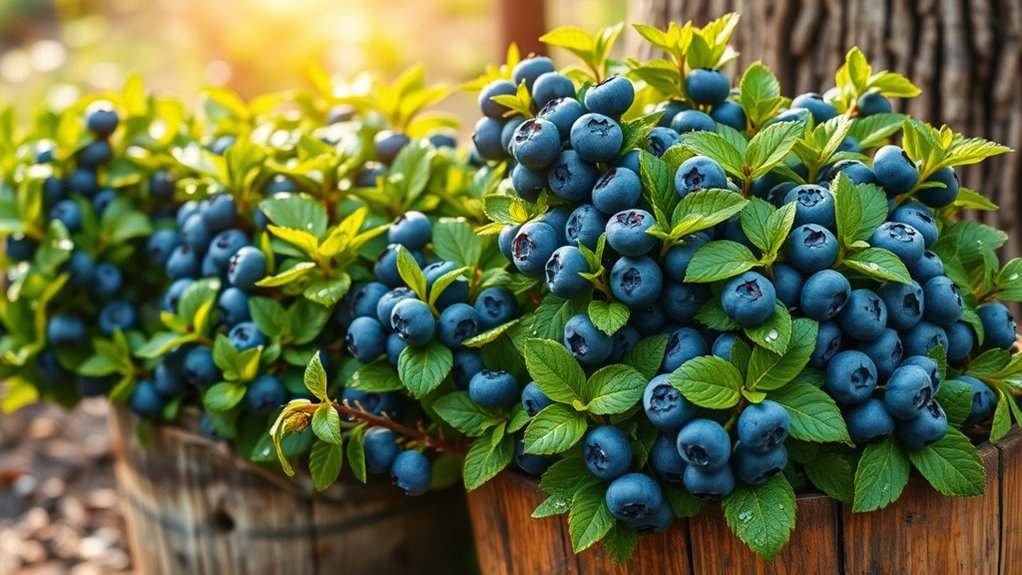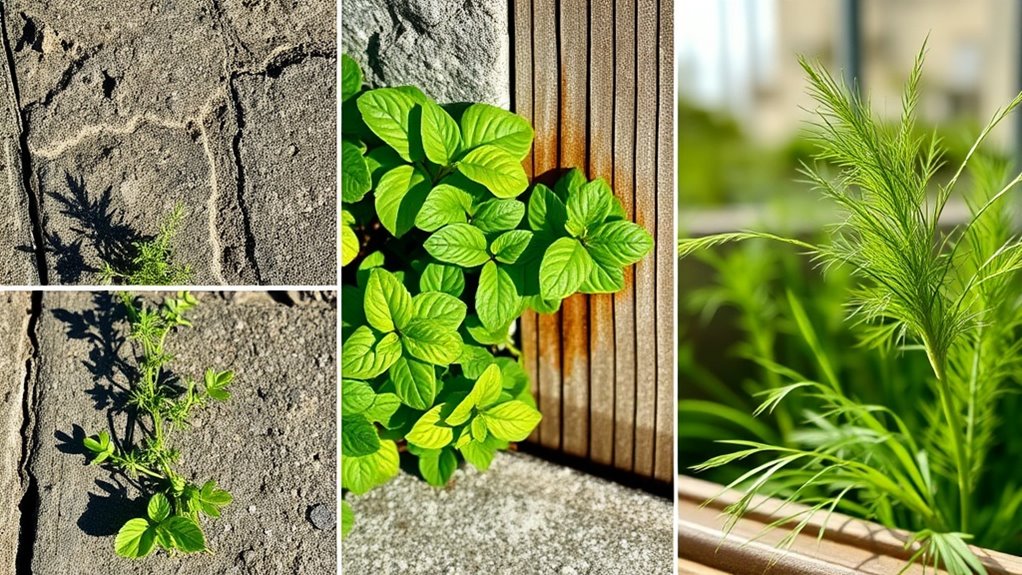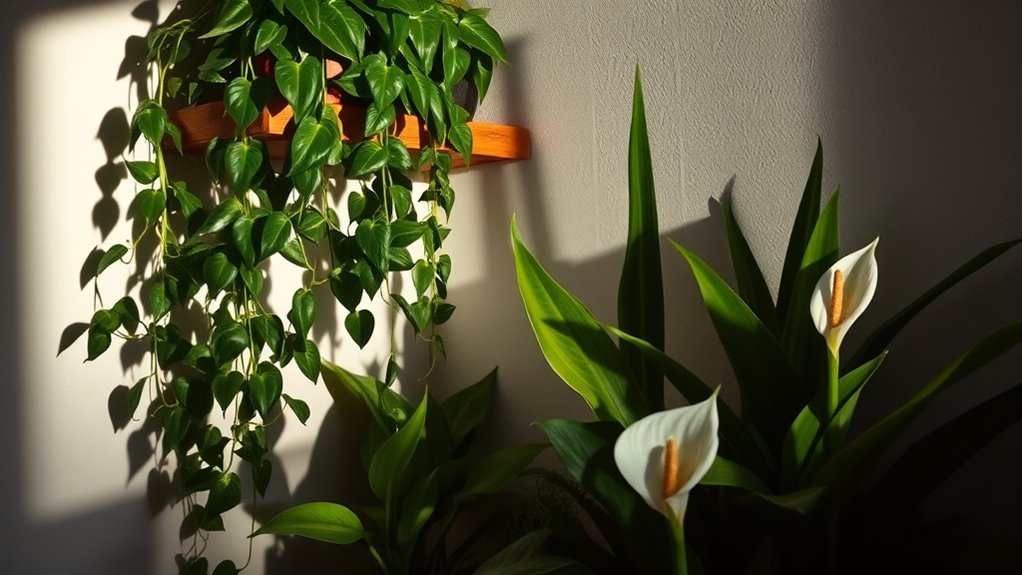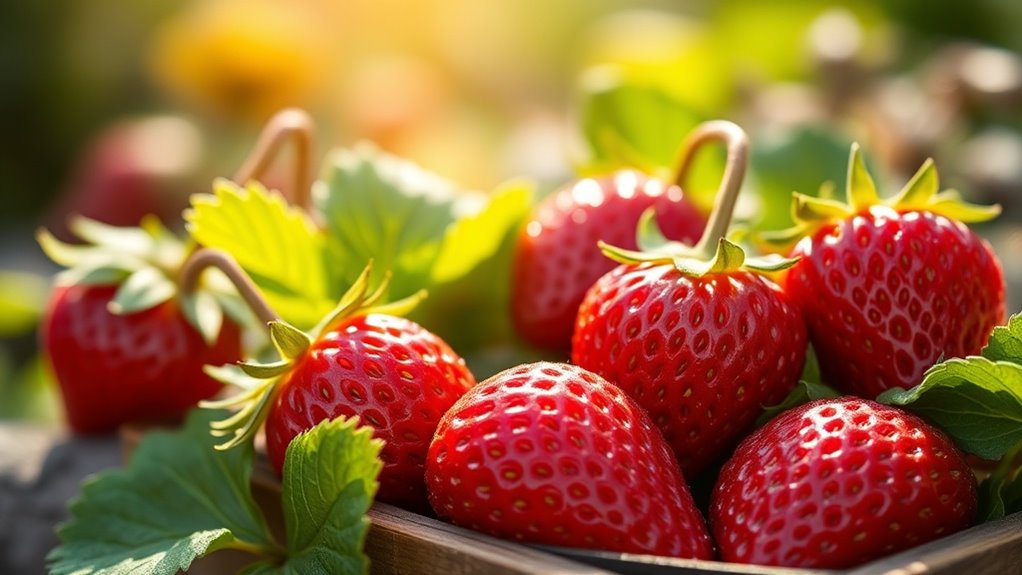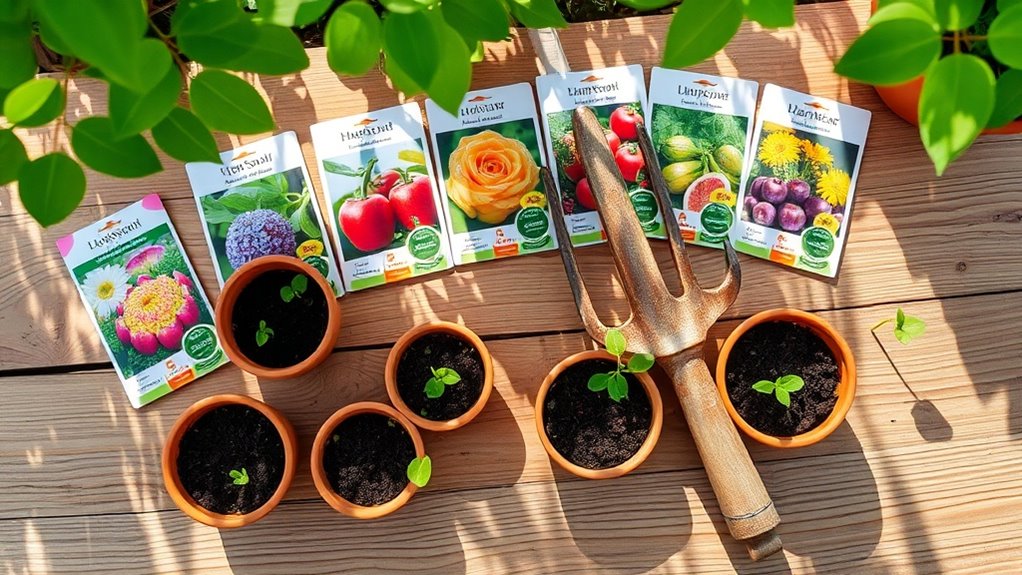The Secret to Growing Blueberries in Containers
Imagine transforming your balcony into a mini blueberry orchard, where fresh berries are just a step away. To achieve this, you’ll need to understand the specific conditions blueberries thrive in. It’s not just about the container; the right soil, watering habits, and sunlight are crucial. Want to know how to create the perfect environment for your blueberry plants? Let’s explore the essential steps together.
Key Takeaways
- Choose at least 12-inch deep containers with drainage holes, and select dwarf blueberry varieties for optimal growth in limited space.
- Maintain soil pH between 4.5 and 5.5 by incorporating peat moss, pine bark, and compost for a nutrient-rich mix.
- Water deeply when the top inch of soil is dry, and consider using drip irrigation or self-watering containers for consistent moisture.
- Ensure blueberries receive six to eight hours of direct sunlight daily; position containers in sunny spots and rotate them for even light.
- Fertilize with acid-based options in early spring, and regularly inspect for pests while using companion planting to deter issues.
Choosing the Right Container
When you’re choosing the right container for growing blueberries, it’s essential to consider a few key factors.
First, opt for a pot that’s at least 12 inches deep and wide to accommodate the root system.
Drainage is crucial, so ensure your container has holes to prevent waterlogging.
Materials like plastic, ceramic, or wood work well, but be mindful of insulation properties, especially in extreme temperatures.
If you want to grow fruit in pots, select a variety suited for container gardening, such as dwarf types.
Lastly, remember to position your container in a spot that gets ample sunlight for optimal growth. Additionally, using a well-draining soil mix is vital for maintaining healthy blueberry plants in containers.
Selecting the Ideal Soil Mix
When growing blueberries in containers, selecting the right soil mix is crucial for their success. You’ll want a mix that maintains an acidic pH level, ideally between 4.5 and 5.5, to support healthy growth. Incorporating organic components like peat moss and pine bark won’t only enhance drainage but also provide essential nutrients for your plants. Additionally, be aware that signs of acidic soil can help you monitor the health of your blueberry plants and ensure they thrive in their container environment.
Ph Level Importance
How crucial is pH level in growing blueberries? It’s essential! Blueberries thrive in acidic soil with a pH between 4.5 and 5.5.
If your soil’s pH is too high, your plants won’t absorb nutrients effectively, leading to poor growth and lower yields.
To ensure your blueberries flourish, test the soil pH regularly. You can use pH test kits or meters for accurate readings.
If adjustments are needed, consider adding sulfur or peat moss to lower the pH.
Organic Components Needed
Maintaining the right pH level is just the beginning of creating an ideal environment for your blueberries. You’ll need a well-draining, organic soil mix rich in nutrients. Here’s a simple breakdown of essential organic components to include:
| Component | Purpose | Ratio |
|---|---|---|
| Peat Moss | Retains moisture | 40% |
| Pine Bark | Improves drainage | 30% |
| Compost | Provides nutrients | 30% |
Mix these components thoroughly to ensure your blueberries thrive in their container. This blend helps maintain acidity, ensuring healthy growth and abundant fruit.
Watering Techniques for Blueberries
Watering blueberries in containers requires a thoughtful approach to ensure these plants thrive.
Start by checking the soil moisture regularly; it should be consistently damp but not soggy. Use a moisture meter for accuracy.
Water deeply when the top inch of soil feels dry, allowing excess water to drain from the bottom.
Consider drip irrigation or self-watering containers for consistent moisture.
Blueberries prefer acidic environments, so avoid hard water; instead, use rainwater or distilled water when possible.
Mulching helps retain moisture and maintain soil temperature, ensuring your blueberries stay healthy and productive throughout the growing season. Additionally, watering in the early morning hours is beneficial as it reduces evaporation and allows plants to absorb moisture effectively.
Sunlight Requirements for Container Growth
After ensuring your blueberries receive adequate moisture, the next key factor for their success in containers is sunlight.
Blueberries thrive in full sun, so aim for at least six to eight hours of direct sunlight each day.
This exposure helps promote healthy growth and bountiful fruit production. To further enhance your container gardening experience, consider using innovative techniques that can optimize growth and yield.
Here are some tips to maximize sunlight for your container plants:
- Position containers in the sunniest spot available.
- Rotate pots occasionally to ensure even light exposure.
- Use reflective surfaces nearby to enhance light.
- Monitor for any shading from nearby plants or structures.
Fertilizing Your Blueberry Plants
When it comes to fertilizing your blueberry plants, choosing the right type is crucial for promoting healthy growth and maximizing fruit production.
You’ll want to look for an acid-based fertilizer specifically formulated for blueberries, as they thrive in acidic soils.
Additionally, timing your applications correctly can make a significant difference, so be sure to fertilize in early spring and again after the harvest for the best results. Incorporating natural ingredients into your fertilizer can enhance its effectiveness and support sustainable gardening practices.
Choosing the Right Fertilizer
How do you ensure your blueberry plants thrive in containers?
Choosing the right fertilizer is crucial.
Blueberries prefer acidic conditions, so look for fertilizers specifically formulated for them.
Here are some key points to consider:
- Acidic pH: Select fertilizers with a pH around 4.5 to 5.5.
- Slow-release options: These provide nutrients over time, preventing harsh spikes.
- Organic choices: Consider using options like cottonseed meal or fish emulsion for a natural boost.
- Micronutrients: Ensure it contains iron and magnesium to support healthy growth.
With the right fertilizer, your blueberries will flourish and produce delicious fruit!
Application Timing Tips
What’s the best timing for fertilizing your blueberry plants?
You should fertilize in early spring, just as new growth begins. This encourages strong root development and healthy foliage.
A second application can be done in late spring, around flowering time, to support fruit formation.
If your plants are in containers, consider a liquid fertilizer for quicker absorption.
Avoid fertilizing in late summer or fall, as this can promote new growth that may not harden off before winter.
Always check the soil pH; blueberries thrive in acidic conditions, so adjust your fertilization routine accordingly to maintain optimal health.
Managing Pests and Diseases in Containers
Have you noticed your blueberry plants struggling with pests or diseases?
Managing these issues in containers requires vigilance and proactive measures.
Start by regularly inspecting your plants for signs of trouble.
Here are some practical tips:
- Use organic insecticides: Neem oil can effectively control pests without harming beneficial insects.
- Implement companion planting: Marigolds and basil can deter pests naturally. Additionally, consider pairing your blueberries with companion plants that can help enhance their growth and deter unwanted insects.
- Maintain cleanliness: Remove fallen leaves and debris to prevent fungal diseases.
- Monitor watering: Overwatering can lead to root rot and other issues.

